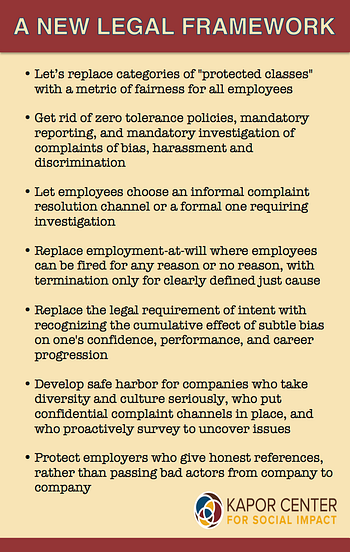Last month, during the height of the Ellen Pao trial, I met with a number of social entrepreneurs in the Bay Area.
I raised the idea that the lack of diversity in tech is a byproduct of the lack of diversity among funders and investors. This must have hit a nerve. A senior partner from a top-tier VC quickly got defensive.
“Quotas,” he said, “would ruin everything.” Nobody had been talking about quotas.
Afterwards, an older white woman spoke up in a strange defense of the VC. “Oh that’s just how he always reacts,” she said. “He’s not really a bigot.” She continued:
“It’s a good thing you don’t need him to invest in your companies — he doesn’t like being challenged.”
This encounter highlights the central problem of why it is so hard to fix biases: Those in power think that they’re being fair. They also believe they’ve reached the top of their field because they are better and smarter than others. Any challenge to these beliefs feels like a personal attack, and is met with a circular logic that reinforces the comfortable assumption that they sit atop a meritocracy.
Challenging these prevailing assumptions can bring retaliation. Even in the room full of powerful entrepreneurs, no one spoke out against the VC. Imagine how it must be for employees – whose job may be at risk – or a startup whose funding would be threatened.
For years* I’ve conducted research on hidden bias, workplace culture, and the daily slights that accumulate over time, and ultimately drive many women and people of color out of the workplace. Here’s what I’ve found:
HR Departments Don’t Help
A recurring theme from employees is the absence of a safe place to go for problem solving, advice, and informal resolution. Human Resources or People Ops departments are alternately seen as spineless, on the side of management, or, in the worst-case scenario, as the place you go when you want to end your career. This was laid bare when, in a recent meeting with CEOs of Kapor Capital portfolio companies, I asked if any of them had worked with an HR person they thought was really helpful. No one was able to name a single person whom they thought could be a valuable colleague to help them think through issues of culture, diversity, and inclusion at their growing companies.
“A recurring theme is the absence of a safe place to go for problem solving and informal resolution”
Equally unhelpful are outmoded diversity policies that have dominated – and failed – corporate America. Policies that require employees to report behavior they consider inappropriate, triggering an automatic HR investigation s often exacerbate the problem. More often than not, they ensure that no one comes forward. Who would file a formal complaint against her CEO for making a sexist or racist comment? Outdated approaches mean that day-to-day exclusionary and offensive practices stay hidden, along with their cumulative effect of driving women, LGBT employees, and employees of color out the door in disproportionate numbers. Then, when reviewing turnover data, senior managers ask in disbelief, “Why didn’t they stay?”
“Innovation in people practices has lagged behind every other dimension of business”
It would be a major mistake to recommend that VCs and tech companies adopt the policies and practices that have simply not worked in corporate America.
Innovation in people practices has lagged behind every other dimension of business. Even in Silicon Valley, tech has been leveraged less when applied to people ops than to product development, financial operations, manufacturing, and sales. It makes no sense, in a world where the purpose of a startup is to upend an established business or an entire industry, that every company has the same boilerplate policy. For an industry built on innovation, tech has shown a remarkable lack of creativity when it comes to tackling issues of culture and people.
It’s Possible to Build Better People Ops
The good news is there are some decent models out there that work. One of the most innovative approaches to handling bias complaints was developed by MIT. Their ombuds(man)’s office, a confidential body consciously populated by people from different backgrounds, is provided as an alternative for employees and students alike. People who believe they have experienced bias have a choice of using this informal resolution system or a traditional complaint channel. One wonders how such a system could have acknowledged, identified, and addressed the toxic culture described by Ellen Pao in her lawsuit.

Also exciting is a number of new tech companies founded specifically to address hidden bias in all aspects of people ops: everything from flagging exclusionary language in job descriptions, to removing bias from performance review structures, to simply removing gender and race indicators from résumés.
Put simply, policies and complaint practices ought to reflect and enable the culture, not stifle it.
Employment Law Needs a Reboot
When Silicon Valley really wants regulations or laws changed, they go after them aggressively. Don’t like PIPA or SOPA? Undo them. Need to import more talent from other countries because one thinks it’s easier than fixing the leaky pipeline here at home? Expand H1B visas. Net neutrality? Innovating around hotel taxes or taxi licensing fees? It’s all underway. Don’t like Indiana’s or Arkansas’ new “religious freedom” laws? Speak out with gusto and get the laws changed. All of this is in stark contrast to the silence of Silicon Valley leaders when it comes to updating U.S. employment laws on bias, harassment, and discrimination.

Just about every so-called “disruptive” startup sends out the same basic offer letter that says, in essence, “Welcome aboard! We’re going to change the world together. But remember, you’re an at-will employee and we can fire you at any time with no reason. Hope you’ll give us your all!”
There is no excuse to keep operating this way.
The Time Is Now
While VCs like the one I encountered may have been encouraged by the jury’s verdict in the Pao case, he would be wrong to get too comfortable. The status quo is on the verge of change, as it was in 1991.
Twenty-four years ago, the entrenched “boys club” of Washington, DC breathed a similar sigh of relief when Clarence Thomas was confirmed to the Supreme Court, despite the jaw-dropping harassment disclosures of Anita Hill. As it turned out, his confirmation almost immediately sparked an avalanche of change.
Just one month after Justice Thomas joined the Court, federal sexual harassment law was dramatically strengthened. The next year, more women than ever before sought — and won — seats in the House and Senate. Thomas, and the last gasp of antiquated patriarchy he came to represent, had won the battle but lost the war.
There is no doubt that Ellen Pao has put the issues of bias, discrimination, and workplace culture in Silicon Valley at the top of the tech conversation. Thanks to Pao and many others, the problem is no longer disputable.
Fortunately, Silicon Valley is in the business of creating innovative solutions.
*In 1984, my doctoral dissertation examined, in part, the differing ways men and women view the continuum of unwanted sexual attention at work. Men saw jokes, touching, requests for dates all clustered together, and attempted or actual sexual assault at the other end of the continuum. Women saw all the behaviors in an escalating continuum from sexual comments through attempted and actual sexual assault.

